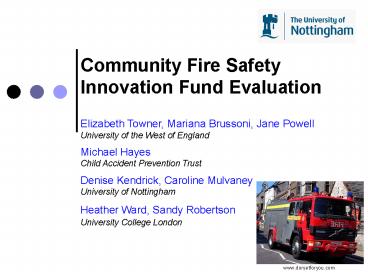Community Fire Safety Innovation Fund Evaluation PowerPoint PPT Presentation
1 / 17
Title: Community Fire Safety Innovation Fund Evaluation
1
Community Fire Safety Innovation Fund Evaluation
Elizabeth Towner, Mariana Brussoni, Jane
Powell University of the West of England Michael
Hayes Child Accident Prevention Trust Denise
Kendrick, Caroline Mulvaney University of
Nottingham Heather Ward, Sandy
Robertson University College London
www.dorsetforyou.com
2
Background
- Those living in socially deprived areas are most
at risk of fire - (Lyons, 2003 Hippisley-Cox, 2002 Roberts,
1997). - Changing culture of the Fire and Rescue Service
(FRS) - (Bain Report, 2002).
- Our Fire and Rescue Service (White Paper) 2003
strategy for reducing fires and saving lives - Accidental fires in the home largest single
cause of deaths and injuries. Growing trend in
deliberate fires an increase of gt 25 since
1996. - 43m invested into Community Fire Safety and
Arson Reduction programmes.
3
Community Fire Safety Innovation Fund
- The Fund was established in 2003 to encourage
fire prevention activity. - Aims of the fund
- assist in drive to reduce fires and fire related
casualties - reduce the level of inequality in the incidence
of fire and fire related casualties - identify successful local community fire safety
approaches that can be rolled out across England
and Wales
4
Community Fire Safety Innovation Fund
Funds allocated to fire and rescue authorities
(FRA) with highest death rates 2003/4 11 FA
1m 2004/5 7 FA 1.5m 2005/6 8 FA 2m
- Typical interventions
- Home fire risk assessments
- Community fire stations
- Youth fire safety innovations
- Hard to reach
www.cumbria.gov.uk
5
Community Fire Safety Innovation Fund Evaluation
- Overall aim
- to assess first 2 years of CFSIF
- Phase I
- Survey of projects funded in first 2 years
- (conducted in house)
6
Community Fire Safety Innovation Fund Evaluation
- Phase II
- Overall evaluation focus on implementation and
process issues - e.g. working in partnerships, training
- Impact on the number and type of fire incidents
- Impact on inequalities in incidence of fire and
fire related casualties - Costs and benefits
7
Design and methods
A controlled before and after study of 12 FRA
using 12 comparison FRA.
- 12 intervention FRA
- Receipt of funding
- Size of funding
- Urban/rural mix
- Performance ratings (Audit Commission)
8
Methods
- 12 comparison FRA chosen on
- Fire casualty rates prior to funding
- Deprivation
- FRS family grouping
- Completeness of geographical data
9
Methods
- Fire incidents and casualties ODPM.
- Population data Office for National Statistics.
- Each LA was assigned to the appropriate FRS,
summed populations by age and gender. This was
used to estimate person years for calculating
casualty rates.
10
Methods
- Data on the Index of Multiple Deprivation 2004
(IMD2004) - Summarised at Super Output Area level
- (SOA smallest level of neighbourhood statistics)
- Used to describe the level of deprivation at the
- level of the FRA
11
Analyses
- Assessed 3 main outcome measures
- fire casualty rates
- accidental fire casualty rates
- accidental fire rates
- a further 9
For each outcome we compared rates between
intervention and comparison areas post funding,
adjusted for baseline rates and deprivation
12
Analyses 12 outcomes
- All fires
- Fire casualty rates
- Fire non fatal casualty rates
- Fire fatal casualty rates
- Fire rates
- Type of property
- Dwelling fire casualty rates
- Dwelling fire rates
- Motive
- Accidental fire casualty rates
- Accidental fire rates
- Malicious/deliberate fire casualty rates
- Malicious/deliberate fire rates
- Unknown intent fire casualty rates
- Unknown intent fire rates
13
Results
Fire casualty rates (per 100,000 person years)
pre and post funding for intervention and
comparison brigades
Post-funding rates IRR (CI) 1.07 (0.88 to
1.30) P value 0.51 adjusted
for pre-funding fire rates and deprivation
14
Results
Casualty rates (per 100,000 person years) pre and
post funding by quarter for intervention and
comparison FRA.
........ Comparison Intervention
Annual rate of change Pre Post funding
funding Intervention -1
-9 Control -2 -11
IRR Pre-funding 1.02 (0.86 to 1.22) Post-funding
1.09 (0.81 to 1.48)
15
Results
Fire casualty rates by deprivation quartile pre
and post funding for intervention and comparison
FRA.
P 0.22 comparing change in deprivation
gradients pre and post funding between
intervention and comparison FRA.
16
Conclusions
- Aims of the fund
- to reduce the number of fires and fire related
casualties - reductions in fires and fire related casualties
in intervention and comparison FRA - reduce the level of inequality in the incidence
of fire and fire related casualties - no reductions in level of inequalities
17
Final thoughts
- Short time period between funding and evaluation
- Ideally, evaluation designed at the start of the
funding - Innovation Fund introduced at a time of change in
the FRS - difficult to isolate the effect of the fund from
on-going fire safety initiatives - Economic evaluation fund money was spent on
capital investments with medium to long term
benefits - Process evaluation personnel found the
experience rewarding

